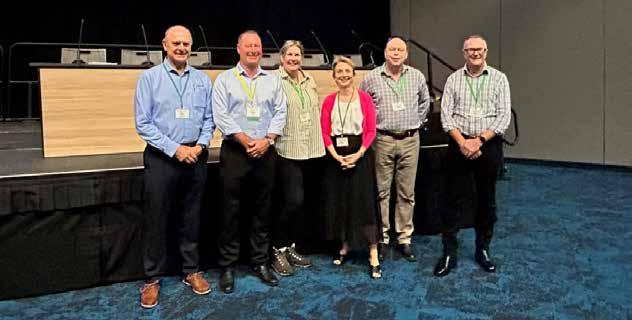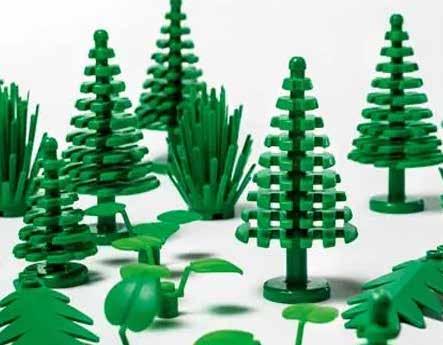
4 minute read
ASSCT CHALLENGES RESEARCHERS TO UNLOCK THE SUGAR PLUS ROADMAP
The 44th Australian Society of Sugar Cane Technologists conference (ASSCT) was held in Cairns in April and included the conference AG field day at SRA’s Meringa station. More than 300 delegates were welcomed to the Cairns Convention Centre by ASSCT 2023 President and SRA Executive Manager Variety Development, Dr Jason Eglinton.
The opening session of the packed program began with an address from Australian Milling Council CEO, Rachele Sheard, followed by an expert panel Q&A discussing Sugar Plus, the industry roadmap, summarised here.
Advertisement
On the following pages we also talk to guest speaker, Dr Robert Speight, Director, Advanced Engineering Biology Future Science Platform, CSIRO talks about how the sugarcane industry can benefit from biofutures, now.
In July 2022 Sugar Plus – a roadmap for the Australian sugarcane industry - was launched by the industry. A plan with a vision to secure and grow value for future generations Sugar Plus acknowledges that strong united voices are needed to encourage exploration and new opportunities, and the critical role science and technology will play.
In April this year, Australian Sugar Milling Council CEO, Rachele Sheard opened the 44th Australian Society of Sugar Cane Technologist’s (ASSCT) conference in Cairns with a presentation that explored the roadmap challenges with an analogy to LEGO, the 90 year old plastic construction toy.
“I loved LEGO growing up,” Rachele said, after a sea of hands had responded to her opening question ‘Hands up here who loves LEGO?’
“The way we use LEGO has changed since I was a young girl playing where a door with a hinge was a major LEGO innovation,” she said.
“Nowadays, a trip around any LEGO superstore reveals the innovation and sophistication behind the twice named toy of the century. And a lot like LEGO, the sugar industry has changed, developed and become more sophisticated,” she said.
“Already our industry is more than just sugar– we produce molasses, cogenerated power and bio-ethanol. But as an industry we need to develop the next wave of innovation and development.”
The Sugar Plus roadmap sets out a series of actions in the near, medium, and longer term, to strengthen and build the industry while charting a path to a bigger, bolder future, built on the foundation of raw sugar production.
While some parts of the roadmap are focused on better business-as-usual and adding value to current operations across the value chain, other parts are about the steps it is believed the industry needs to take to unlock the vast opportunities presented by the bioeconomy.
“The vision and roadmap are not designed to be disruptive to today’s industry nor displace existing sugarcane and raw sugar production,” Rachele said.
“The objective is to increase sugarcane value per hectare and make sugarcane the economic choice for those hectares that are available, increase mill revenue and ability to invest in the future, and maximise the incentive to expand sugarcane production substantially over the medium to long-term to meet emerging bioenergy and green energy demand.
“Science and technology will play a critical role in delivering the roadmap and vision and that requires securing our licence to operate through strong environmental, social and governance credentials while addressing the everpresent threat to our biosecurity,” she said.
Following the conference opening address, Rachele joined industry partners CANEGROWERS Senior Manager Industry, Burn Ashburner, SRA CEO Roslyn Baker, Australian Cane Farmers Association General Manager Stephen Ryan and Department of Agriculture and Fisheries Executive Director Elton Miller for a Q & A panel on the roadmap, chaired by SRA Executive Manager Variety Development and ASSCT President Dr Jason Eglinton.
Roslyn Baker responded to questions about sustainability and biosecurity.
“As an industry we fear sustainability, but we know what the threats are,” Roslyn said.
“We need to prove, embrace and be world leaders in sustainable sugarcane production.
“With a changing climate and environment, new varieties are our future. Disease resistance is critical for crop protection. But while we chase our full potential, we shouldn’t forget the fundamentals. The threat to biosecurity is our greatest concern. We mustn’t take our eye off that ball, and we’re not,” she said.
So where to next?
“We need to be better than the best we have ever been to achieve our vision,” Rachele said.
“Now is the right time because opportunity exits if we work together,” Stephen Ryan added.
In Australia alone, domestic demand is 10 billion litres of sustainable aviation fuel and 3.5 billion kilograms of bioplastics.
“There is already a great deal of activity at the growing and milling levels individually and by region. You only need to look at the Mackay bio-energy hub to see this,” Rachele said.
“But there is no path forward towards the industry vision without research, development, and engineering.”
“Government will be a critical partner to make this happen and is already playing a positive role with investment in bio-energy hubs and the establishment of the Jet Zero Council, but industry collaboration and leadership at all levels will be the driving force.”
Rachele concluded her presentation with a challenge for delegates at the
LEGO® FACTS
conference; to identify the research and development, and extension and adoption, that is fit for the future of the industry; to unlock the Sugar Plus vision. A challenge that SRA’s presenters at ASSCT are already rising to and reaching out for.
Sugar Plus
Our vision is to become a vibrant, transforming industry, sustainably producing sugar and bioproducts at the heart of regional communities. Read more about the industry roadmap Sugar Plus – Fuelling the Future of Food, Energy and Fabrication on SRA’s website.
LEGO ® has been named “Toy of the Century” twice. Products have undergone extensive development over the years – but the foundation remains the traditional LEGO brick.
The interlocking principle with its tubes makes it unique and offers unlimited building possibilities. It's just a matter of getting the imagination going.
In 2012 a range of sustainable LEGO® elements made from plant-based plastic sourced from sugarcane were produced that included leaves, buses and trees (pictured).









